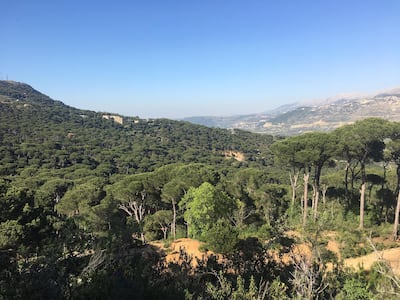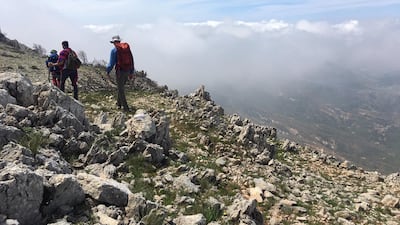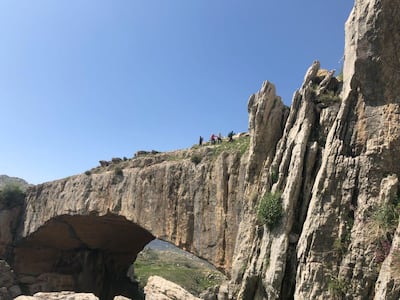"For a moment, I could hear nothing but the gushing water, feel nothing but the breeze on my face and smell nothing but slightly sweetened air," says Dubai resident Rawan Gebran as she recalls her recent trek along the 470-kilometre trail that runs from southern Lebanon to the country's hilly north.
"It really was the most incredible experience of my life and it has changed me forever," she says. "I went without knowing anyone, and I emerged stronger and clear-headed, feeling as if all my energy points were flowing freely."
Originally from Lebanon, Gebran was only just realising her interest in hiking when she first heard about the Lebanon Mountain Trail. “It made sense to tackle the trail in my own country first, before going off to Nepal or to the Alps.
“I wanted to learn more about Lebanon, the nature, the culture. And as both my parents’ families are from the south of the country, I decided it would be poetic to embark on the trail, trekking from south to north,” she says.
Hikers keen to explore the trail have the option to do the same, or to go in the opposite direction, starting at the village of Aandqet in the north of the country and winding to Marjaayoun. Regardless of which direction travellers pick, the trail goes through 76 towns and villages at altitudes ranging from 570 metres to more than 2,000 metres above sea level.
Walkers are welcome all year round, and for as long or as short a distance or period of time as they wish. But every spring, the Lebanon Mountain Trail Association (LMTA) runs a walk that takes trekkers the entire length of the trail.

Winding through valleys between cedarfilled forests, passing natural waterfalls and ancient ruins, hikers can stay in remote guesthouses in what is a breathtaking way to experience the tiny Middle Eastern nation, far removed from the well-trodden streets of downtown Beirut.
A country of contrast
Steeped in history, Lebanon is a country that has, quite literally, been through the wars. It's a place where bullet-riddled buildings sit next to designer boutiques, and where the bustle of mezze-filled lunches battle with the blare of the country's never-ending traffic. It's a nation where tourists can be sunbathing on a beach in the morning and taking pictures on a snow-covered mountain peak in the afternoon.
It’s layered in complexities – and the Lebanon Mountain Trail delves into these in a way that no other landmark in the country can.
For Rabih Abdul Qader, UAE ambassador for the LMTA, it's an experience he fell instantly in love with. Originally from Lebanon, Abdul Qader travelled the globe on hiking trips, so was more than a little surprised when he first heard about a trail in his own country back in 2015.
He joined a friend who was already set to hike part of it. “My experience was amazing,” he gushes. “I had a connection with people that I hadn’t had in a long time. I was also really astonished by the number of foreigners on the trail – more than half the people doing the walk weren’t Lebanese, but Canadian, British, Latin American, European or American.”

Keen to get further more, he volunteered with the association. The not-for-profit NGO works to conserve the region, promote ecotourism and make sure that all of the villages, even remote ones, receive year-round visitors. "I have such a connection with the place," Abdul Qader says. "I grew up in Kalhat, but I remember going to visit my grandmother in Akkroum. I have memories of going there and heading out with my grandmother on the back of a donkey to go to Ain El Sabe' and fill up containers with water. It was one of my favourite things to do, I loved it. So I just wanted to get involved."
Tasting adventure
In his new role as ambassador for the Lebanon Mountain Trail in the UAE, Abdul Qader aims to spread the word about the hike, which he believes offers something truly special. “The idea is that nothing is brought in from outside the regions that are part of the trail. As well as the scenery and the history, it’s also a fantastic food heritage trail. Every guesthouse or village serves dishes that are typical of that particular region. “From the north to the south the culinary staples can be quite different and the LMTA makes sure the food from each region stays in that region.”
In the El Qemmamine region, which is known for its juniper forests, many of which are part of a protected nature reserve, guests can opt to stay at the Wadi el Zouhour guesthouse. In this family-run lodge, Mohammed Taleb welcomes visitors to his home, but the culinary offerings are all the work of his mother, who cooks and serves dishes traditionally eaten in the region. Over dinner, Taleb encourages cultural and idea exchanges, and spends time giving guests a bit of a history lesson on the food they are eating and the area they are staying in.
When the guesthouse first opened, Taleb had his work cut out trying to change the perceptions of some of the villagers. "At first, it was difficult for people to accept the idea of a guesthouse in the village, where foreigners – not only foreigners to the village or to Lebanon, but from other regions and nationalities, be it Arabs or non-Arabs – would sleep. But bit by bit, people began accepting the idea," he says. As more and more tourists discover the mountain trail, the guesthouse and the village as a whole have reaped the benefits, such as the creation of new jobs.

Others benefit, too: Abu Mustafa – a 68-year-old tour guide who has lived his entire life in this hilly region – ensures hikers are in safe hands on the trail winding from Bnine to El Qemmamine, and does so without ever breaking a sweat. Local tour guides are trained and coached by the association, which helps to create jobs in regions that are often far removed from tourist locations.
Walkers benefit, too, learning from local people who are expertly placed to shed light on the indigenous wildlife and plant life in the dramatic valleys, deep gorges and high peaks that the trail embraces.
On the move
As they walk, travellers are privy to an ever-changing canvas. "Last year, we had a group visiting from Canada," says Abdul Qader. "One of them had toured the world, but still claimed that the most beautiful place on earth was British Columbia. But even he said that nowhere he had travelled to had the same diversity as there is here.
"You walk two days and you're in an area filled with olive trees, then you travel another few days and it's all apple trees and vineyards – it's ever-changing. And it's the same in terms of culture and even in history, from Byzantine to Phoenician and more," he says.
From El Qemmamine to Kfar Bnine, the trail winds along footpaths beside forested hills and remote landscapes. Some days, the only company trekkers will have are shepherds herding their sheep or some rarely spotted rock hyrax – a lazy, meerkat-like animal that counts elephants and manatees among its numerous ancestors.
For Souad Sbaiti, an architect based in the UAE, this backdrop was one of the highlights of tackling the walk when she spent a month in the mountains of Lebanon. "I loved how throughout the trail the scenery changed as we travelled and we got to experience all kinds of weather. It snowed on us, it rained on us, but we also had sunny days."
Ancient history
In the Qattara Valley, hikers can explore a cave with a history dating back to the 17th century, when it was used as a hiding place by the Bani Saifa tribe. Those fit for the challenge – and hikers hoping to do the walk certainly need to be fit – can tackle the Valley of Hell or Wadi Jouhanam, so named after its impossibly steep slopes. In the northern village of Sfireh, history buffs can revel in a place named after Roman emperor Septimius Severus, who built temples and fortresses in the village. Here, travellers can wander the second largest complex of Roman ruins in Lebanon, second only to those at Baalbek. In Tannourine, the densest cedar tree forest in Lebanon remains untouched by human destruction. Chalita Tannous has been involved in creating educational and cultural programmes for tourists and visitors to the forest, as a way of letting people learn more about the biodiversity of the reserve, rather than just taking pictures with the forest in the background. It's also a matter of preservation, he says. "Our reserve is small, it's true, but we try to protect it as much as we can," Tannous adds.

Not far from Tripoli lies Bahwayta, and the Chill Yard, a concept created by entrepreneur Georgio Jreij. It offers picnic spots, a cafeteria and a camping site, as well as football, basketball and volleyball facilities in this tiny village far from tourist hotspots. Jreij set up the project as a way to revive the local economy, which was suffering because of emigration.
Local guides are available to join those interested in spending a night under the stars, and can show visitors the best biking, hiking and camping spots.
Harnessing adventure travellers is something else that association is keen on. "Adventure travel is on our radar, too; there are places that are great for biking and camping, or for snowshoeing and skiing," says Abdul Qader.
Pick of the best
For the mountain-trail ambassador, however, there are three places that are extra-special: "Bchareh is beautiful and well worth a visit, even as a stand-alone trip. It's the birthplace of Khalil Gibran and it is amazing – full of culture and so much architecture. It's located in Wadi Qadisha, which is a Unesco World Heritage Site."
The Douma sidetrail is another highlight, he adds. “This trek takes tourists through a very old town where most of the buildings are set with redbrick roofs, all perched on a hillside, making for amazing views among the pine and cedar trees. The guesthouses here are so nice, and the people are really warm-hearted.”
Another place that makes Abdul Qader's top three is the Literary Trail. It combs breathtaking views of Mount Sannine with a 22km trek that takes travellers to literary landmarks dedicated to poets and writers from that area, and is a unique experience. Among the poets featured is Mikhail Naimy, who famously wrote: "Often you shall think your road impassable, sombre and companionless. Have will and plod along; and round each curve you shall find a new companion."
Naimy could have been talking directly about the Lebanon Mountain Trail, which for all its diversity and beauty, has one aspect that stands above all the others: "The real highlight is the people, Abdul Qader says. "Especially in the villages, the people are warm and when they welcome you it is in their homes with a very open heart," .
And that is something that few other trekking trails can equal.



